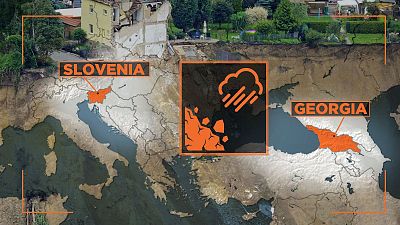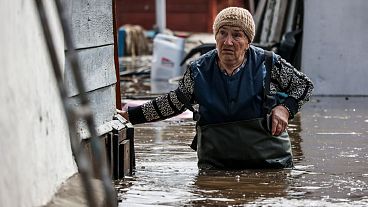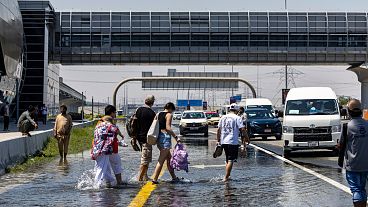Extreme weather across Europe could extend into autumn spurred by record-high sea temperatures.
Monday saw the sea surface temperature of the Mediterranean Sea reach its highest ever recorded temperature at over 28.71C, beating the previous record of 28.25C set in 2003.
Data from the Mediterranean Heat Waves Monitoring Service confirmed that the temperature of the sea had broken new records on Tuesday.
Higher water temperatures mean marine life will be at risk, much like in the heatwaves between 2015 and 2019 when 50 species, including molluscs and corals, were significantly impacted.
The impact of ocean warming will be felt into the autumn and winter months, when the Mediterranean Sea releases the heat it is currently retaining, potentially supercharging storms.
The unprecedented heat released by the sea could trigger heavy rains, not only in southern Europe but throughout much of the rest of the continent as the Mediterranean acts as a source of heat and moisture for much of Europe.
Extreme weather events have been happening across Europe
This summer has seen extreme weather events happening across Europe, from intense wildfires and heatwaves to flash floods and hailstorms.
Hail storms in northern Italy last week injured at least 110 as tennis ball-sized hailstones pummelled the small towns of Lombardy in northern Italy.
While in the south of Italy temperatures climbed above 46C, some hospitals in Rome have seen a 20 to 25 per cent increase in people arriving at emergency units due to dehydration or other heat related illnesses.
In Croatia, a similar heatwave has killed six people. Wildfires in Greece have burnt across several islands, including Corfu and Rhodes, forcing thousands to evacuate.
Spain has seen flash floods in the north-east city of Zaragoza which have caused havoc on the streets, while drought still takes hold of much of Spain’s eastern and southern regions, like Catalonia and Andalusia.
What is causing such extremes in the weather?
Italy has been particularly hard hit by so called ‘weather whiplash’, worsened by various weather phenomena.
“Northern Italy is on the border between two different air masses, or jet streams,” Dr Giulio Betti, meteorologist at the Italian National Research Council explains to Euronews Green.
“The southern one came from the Sahara Desert which is very dry and capable of creating a huge quantity of humidity and moisture. At the same time northern Europe is touched by cool and unsettled air masses from the north Atlantic. This mix of different air masses triggers exceptionally severe storms.”
Much of southern Europe lies in this area between the two air masses or jet streams, meeting in the middle where central northern Italy lies, creating severe changes in weather compared to the heatwaves in the south of the country.
This conflict of jet streams also affects border regions including northern Spain and the Balkans which have also seen extremes in weather compared to northern Europe.
While these weather systems, along with El Niño, are exacerbating the extremes seen in Europe, analysis shows a clear link with human-caused climate change.
The World Weather Attribution group has concluded that the recent heatwaves in Europe were made at least 950 times more likely by global heating.
Heatwaves will take longer to pass in the future
Because of the cooler climate of northern Europe conflicting with the increasing heat of the south it’s likely that more extreme weather will be seen in the future, compounded by human-made climate change.
“Around the northern hemisphere there have been domes of heat building, which we’ve seen in the Mediterranean,” a MET office spokesperson tells Euronews Green. “Because the jet stream has buckled, it allows these domes of heat to build up and then the dome is incredibly hard to move for other weather systems to come and replace it.”
The heatwave across Italy and much of southern Europe and north Africa has been going on for weeks as anticyclone Cerberus makes its way through the continent.
“As we’ve seen across Europe and north Africa that once these systems are established, they are incredibly difficult to move,” the MET Office spokesperson adds.



